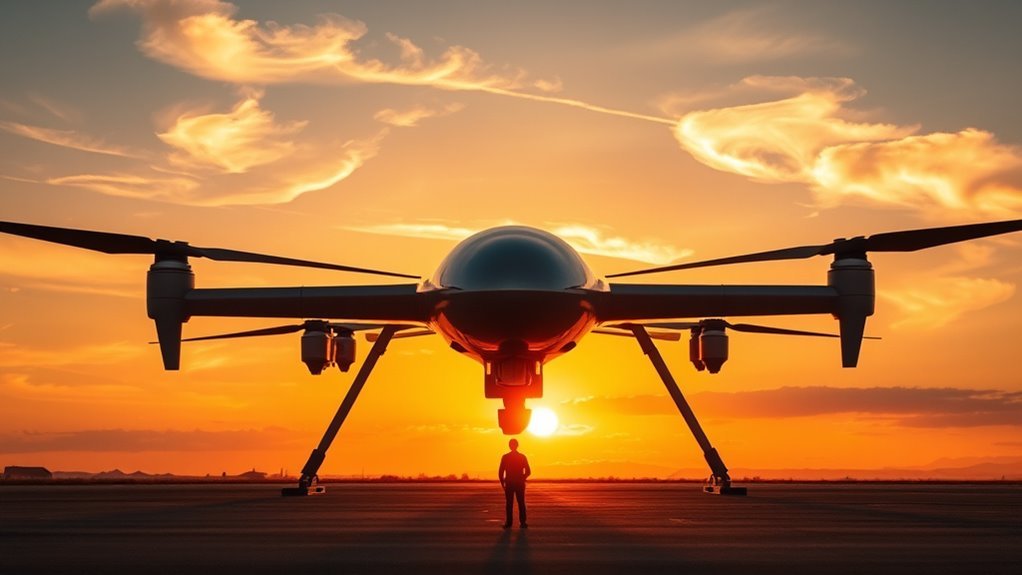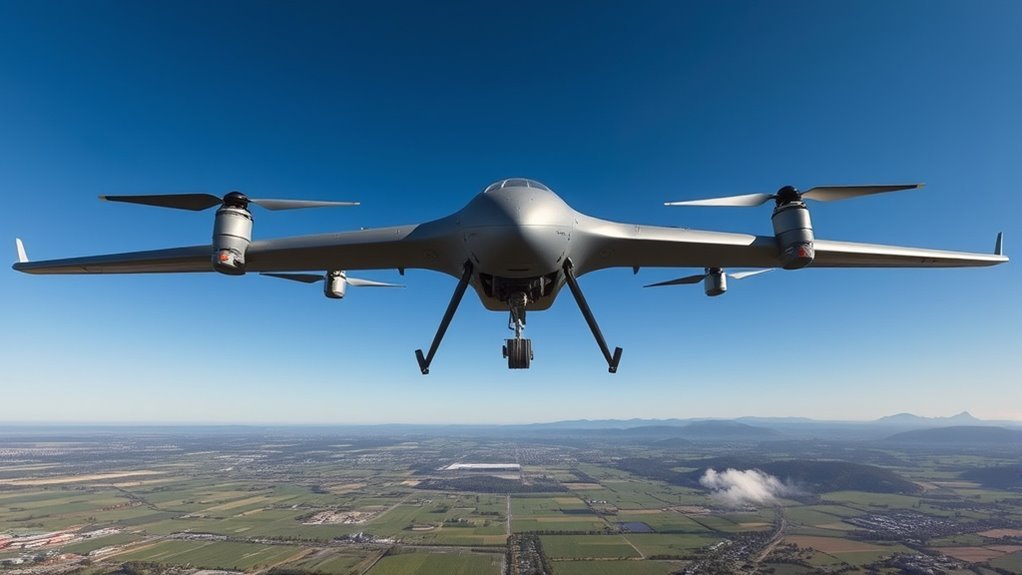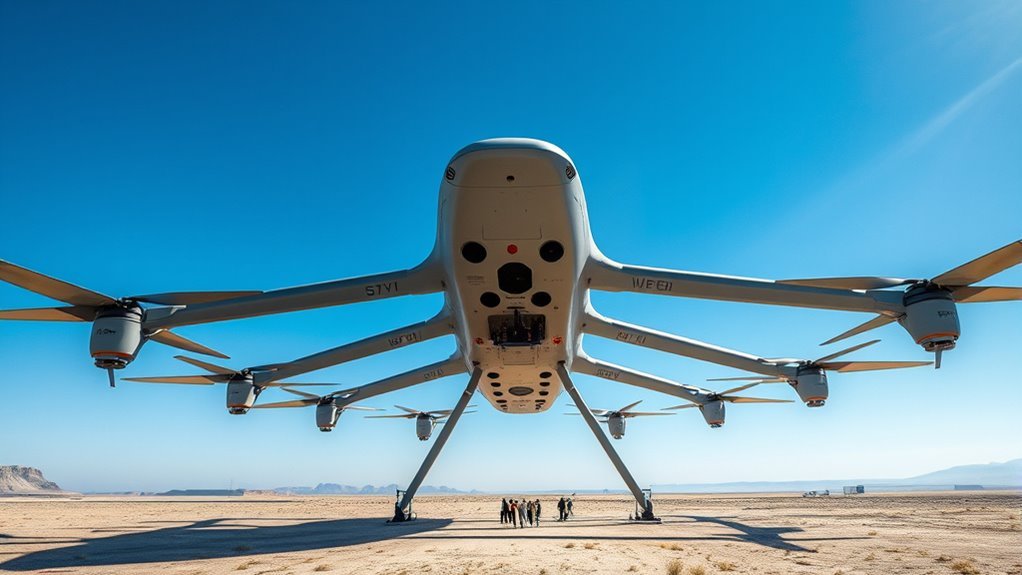The biggest drone in existence is the Global Hawk, featuring an impressive wingspan of approximately 130 feet. It’s engineered for high-altitude surveillance and long-range missions, equipped with advanced sensors for real-time data collection. Weighing considerably more than smaller models, the Global Hawk can carry a substantial payload. Its capabilities enhance military operations and gather critical information over vast distances. If you’re curious about its features and applications, there’s much more to uncover.
Overview of Drones

Drones, or unmanned aerial vehicles (UAVs), have revolutionized various industries by enabling precise aerial operations without the need for onboard human pilots. You’ll find multiple drone types, each designed for specific tasks—such as quadcopters for recreational use, fixed-wing drones for agricultural monitoring, and hybrid models for versatile applications. Understanding these categories is essential for effective deployment. However, maneuvering through drone regulations can be complex. These regulations vary by region and dictate aspects like flight altitude, no-fly zones, and operational permissions. You’ll need to familiarize yourself with these rules to guarantee compliance and maximize the freedom drones provide. Additionally, awareness of the signal penetration challenges faced by drones is crucial for optimizing their operational capabilities. Battery life and power management are also vital factors to consider for maximizing the range of your drone. By comprehending both drone types and regulatory frameworks, you empower yourself to harness the full potential of UAV technology.
The Evolution of Drone Technology

To understand the evolution of drone technology, you need to contemplate key historical milestones that shaped its development. From early military applications to the latest advancements in autonomous flight, each stage reflects significant progress in aerial technology. Analyzing these developments reveals how innovation has transformed drones into versatile tools across various industries. Furthermore, advancements in robotic autonomy have enabled drones to operate independently in complex environments, enhancing their effectiveness in modern defense operations. The integration of AI-driven autonomy has further revolutionized drone capabilities, allowing for precision strikes and real-time reconnaissance in dynamic scenarios.
Historical Milestones in Drones
As the demand for aerial technology grew, significant milestones emerged, shaping the evolution of drones into the sophisticated tools they are today. Understanding drone history reveals a timeline of aerial innovations that have transformed various industries.
| Year | Milestone |
|---|---|
| 1917 | First military drone, the Kettering Bug, tested. |
| 1980s | Development of UAVs for reconnaissance in military applications. |
| 2000s | Commercial drones emerge, enabling widespread use in agriculture and photography. |
These milestones illustrate how drones evolved from basic models into advanced platforms, enhancing capabilities in surveillance, mapping, and delivery. Your understanding of these historical advancements can empower you to appreciate the freedom and potential that modern drones offer.
Advancements in Aerial Technology
The progression of drone technology has been marked by remarkable advancements that have expanded their capabilities beyond military applications. Today, drone innovations in aerial robotics are shaping various industries, giving you the chance to explore new possibilities. Consider the following advancements:
- Autonomous Flight: Drones can now navigate complex environments with minimal human intervention, enhancing efficiency and safety.
- Payload Capacity: Increased payload capabilities enable drones to transport heavier loads, making them invaluable for logistics and delivery services.
- AI Integration: Advanced algorithms are improving real-time decision-making, allowing for smarter operations in dynamic conditions.
These developments not only enhance functionality but also promote the freedom to utilize drones in diverse fields, from agriculture to emergency response. Embrace the future of technology and its transformative potential.
Introducing the Largest Drone

The largest drone currently in existence boasts impressive dimensions and weight that considerably enhance its capabilities. You’ll find that its purpose spans various applications, from military use to commercial logistics. Notable features and advanced technology set this drone apart, making it a pivotal innovation in the aerial robotics field.
Dimensions and Weight
When you consider the largest drone in existence, its dimensions and weight are nothing short of astonishing. Understanding the drone’s specifications gives you a clear view of its capabilities. Here are some key metrics:
- Wingspan: The drone boasts an impressive wingspan of approximately 40 feet, allowing for enhanced lift and stability.
- Length: Measuring around 30 feet in length, it provides ample space for advanced technology and payload.
- Weight: This titan weighs in at about 5,000 pounds, necessitating robust engineering to manage its flight dynamics.
These dimensions specifications and weight measurements highlight the drone’s formidable presence in the sky, embodying the freedom to explore vast territories with precision and power.
Purpose and Applications
While many drones serve specific niches, the largest drone in existence fundamentally transforms multiple industries with its unique capabilities. Its applications span logistics, agriculture, and environmental monitoring, enabling efficient transport of goods across vast distances while considerably reducing operational costs. In agriculture, it optimizes crop management through precise aerial surveys, enhancing yield and sustainability. However, as its capabilities expand, so do the challenges related to drone regulations. Striking a balance between innovation and compliance is essential to mitigate potential risks. In addition, its environmental impact warrants attention; utilizing advanced technologies can minimize carbon footprints while maximizing resource efficiency. By embracing these applications, you can harness the potential of this monumental drone, contributing to a more sustainable and efficient future.
Notable Features and Technology
With a wingspan exceeding 400 feet, the largest drone in existence showcases cutting-edge technology that redefines aerial capabilities. This drone isn’t just massive; it’s equipped with features that elevate its performance and versatility. Here are three notable aspects:
- Advanced Sensors: These integrated systems enable real-time data collection and enhanced situational awareness, essential for various applications.
- Flight Autonomy: With sophisticated algorithms, it can navigate independently, making it ideal for long missions without constant human oversight.
- Payload Capacity: Designed to carry substantial loads, it can transport equipment and supplies efficiently over vast distances.
This combination of advanced sensors and flight autonomy makes the largest drone a revolutionary tool for exploration and operational freedom.
Key Features of the Biggest Drone
Although the biggest drone in existence boasts impressive dimensions and capabilities, its key features highlight the innovative engineering behind its design. You’ll find advanced drone technology integrated throughout, allowing for unparalleled stability and control, even in challenging environments. The drone utilizes cutting-edge materials, minimizing weight while maximizing durability, an essential factor in aerial innovations. It’s equipped with a sophisticated navigation system that enables precise positioning and autonomous flight paths, enhancing operational efficiency. Additionally, the most advanced drones, like the Amazon MK30, are designed to support impressive payload capacities, accommodating various sensors, cameras, or equipment, making it versatile for multiple applications. In addition, energy-efficient propulsion systems extend flight duration, ensuring extensive operational range. This combination of features positions the drone at the forefront of modern aerial technology, catering to the need for freedom in exploration and functionality. Furthermore, the drone’s collision avoidance system ensures safety by detecting obstacles in real-time, enhancing its operational reliability.
Purpose and Applications
The enormous capabilities of the biggest drone in existence make it a game-changer across various sectors. You’ll find its applications span several significant areas, enhancing efficiency and effectiveness. Here are three primary purposes:
The largest drone revolutionizes industries, offering unprecedented efficiency through diverse applications in delivery, surveillance, and agriculture.
- Drone Delivery: This drone can transport goods quickly, addressing logistical challenges in remote or hard-to-reach areas.
- Aerial Surveillance: With advanced sensors and cameras, it provides real-time surveillance for security, disaster management, and environmental monitoring.
- Agricultural Monitoring: Farmers utilize it for crop analysis, pest detection, and resource management, optimizing yields and sustainability. Additionally, it can support autonomous spraying operations, allowing for precise and efficient application of resources.
These applications not only elevate operational standards but also promote freedom in accessing resources and information remotely, revolutionizing how industries function. The potential is vast, enabling innovative solutions to modern challenges.
Comparison With Other Large Drones
When you consider the largest drones, it’s crucial to compare their size and capabilities with notable counterparts like the MQ-9 Reaper and Global Hawk. Each of these drones serves distinct roles across various industries, showcasing unique applications that highlight their technological advancements. The evolution of UAV technology will offer valuable insights into the evolution and specialization of large unmanned aerial vehicles, particularly with advanced navigation algorithms that enhance operational efficiency and safety.
Notable Large Drones
Several notable large drones have emerged in recent years, each showcasing unique capabilities and specifications. As you explore the world of drone technology, it’s essential to recognize the advancements in large UAVs that serve various applications.
- Northrop Grumman Global Hawk – Known for its high-altitude surveillance, this drone can cover vast distances without refueling.
- MQ-9 Reaper – A versatile system used for both reconnaissance and strike missions, it boasts advanced targeting capabilities.
- Airbus Zephyr – A solar-powered UAV that can remain airborne for extended periods, ideal for persistent surveillance.
These large UAVs highlight the diverse functionalities that modern drone technology provides, expanding operational possibilities while enhancing strategic advantages in various fields.
Size and Capabilities
Large drones like the Northrop Grumman Global Hawk and MQ-9 Reaper not only demonstrate impressive technological advancements but also vary considerably in size and capabilities. The Global Hawk boasts drone dimensions of 130 feet in wingspan, enabling extended missions with robust aerial capabilities, including surveillance and reconnaissance over vast distances. In contrast, the MQ-9 Reaper, with a wingspan of 66 feet, excels in precision strikes and intelligence gathering. While both drones serve critical roles, their differing dimensions and capabilities highlight the versatility of drone technology. You’ll notice that larger drones often offer enhanced payload capacity and endurance, but smaller drones can maneuver more nimbly in complex environments. Understanding these distinctions helps you appreciate the evolving landscape of unmanned aerial systems.
Applications in Industries
Although various industries employ large drones for distinct purposes, the applications often reveal their unique strengths and capabilities. Here’s a closer look at how these drones excel compared to others:
- Agricultural Monitoring: Large drones can cover vast fields quickly, providing real-time data on crop health and soil conditions, which enhances efficiency.
- Disaster Response: In emergency scenarios, these drones can rapidly assess damage, deliver supplies, and aid in search-and-rescue operations, proving critical for timely interventions.
- Infrastructure Inspection: Their ability to carry high-resolution cameras allows for thorough inspections of bridges and power lines, reducing human risk and increasing reliability.
The Engineering Behind the Giant
The engineering behind the largest drone in existence showcases a remarkable fusion of advanced materials, aerodynamic design, and cutting-edge technology. You’ll find that every component is meticulously designed to optimize performance while maintaining structural integrity. This balance allows the drone to withstand harsh conditions and heavy payloads without compromising safety. Additionally, the integration of advanced vibration dampening systems enhances stability, especially in challenging flight conditions. The drone’s design is also influenced by principles similar to those found in Draganfly’s rugged design, which emphasizes durability and efficiency.
| Component | Material Used | Function |
|---|---|---|
| Frame | Carbon Fiber | Provides lightweight strength |
| Wings | Composite Materials | Enhances aerodynamic design |
| Propulsion System | High-Efficiency Motors | Maximizes thrust-to-weight ratio |
| Control Systems | Advanced Sensors | Guarantees stability and maneuverability |
Impact on Military Operations
Advancements in drone technology, exemplified by the largest drone, markedly influence military operations. These drones offer significant tactical advantages, enhancing situational awareness and operational efficiency. You’ll find that their capabilities can be categorized into three key areas:
Advancements in drone technology significantly enhance military operations, providing tactical advantages in surveillance, precision strikes, and operational reach.
- Surveillance Capabilities: Drones can monitor vast areas in real-time, providing critical intelligence.
- Precision Strikes: They enable targeted actions with minimal collateral damage, improving mission effectiveness.
- Extended Reach: Their ability to operate in hostile environments reduces risk to personnel, allowing for safer missions.
Influence on Commercial Industries
As industries increasingly adopt drone technology, significant transformations are occurring across various commercial sectors. In commercial logistics, drones streamline deliveries, enhancing efficiency and reducing costs. Agricultural surveying benefits from precision aerial data, optimizing crop yields and resource management, including insights from crop monitoring cameras that track plant health in real time. Aerial photography has revolutionized marketing strategies, providing stunning visuals that captivate audiences. In disaster response, drones enable rapid assessment and facilitate search and rescue operations, saving lives. Infrastructure inspection improves safety and reduces downtime through real-time monitoring, while energy inspections guarantee operational efficiency. Environmental monitoring and wildlife conservation efforts leverage drones to gather critical data with minimal disturbance. Additionally, construction management utilizes drones for site surveys, assuring projects remain on schedule and within budget, reflecting the technology’s profound impact across these diverse industries. Moreover, enhanced stability and performance offered by advanced stabilization systems ensures reliable operations in challenging environments, further elevating the capabilities of drone applications.
Future of Large Drones
Large drones are poised to play a transformative role in various sectors, building on the foundation laid by their smaller counterparts. As you consider the future of large drones, keep these key points in mind:
- Future Innovations: Expect advancements in AI and automation, enhancing operational efficiency and autonomy.
- Expanded Applications: Large drones could revolutionize logistics, agriculture, and disaster response, increasing accessibility and reducing costs.
- Potential Challenges: Regulatory hurdles and public perception may impede progress, requiring proactive measures to guarantee safety and acceptance. Additionally, innovations in intelligent flight modes will further enhance the versatility and usability of large drones in various applications.
Frequently Asked Questions
What Materials Are Used to Construct the Biggest Drone?
Imagine crafting a bird that soars effortlessly; for that, you’d use carbon fiber and lightweight alloys. These materials provide strength and agility, letting you achieve remarkable performance while embracing the freedom of the open skies.
How Much Does the Largest Drone Weigh?
When considering drone specifications, the weight comparison reveals that the largest drones can exceed 30,000 pounds. This substantial weight impacts their operational capabilities, influencing range, payload, and overall performance in various environments.
What Is the Maximum Flight Altitude of the Biggest Drone?
Imagine soaring high above the earth, where the maximum altitude of advanced drones reaches 60,000 feet. Such drone capabilities revolutionize technology, enabling unparalleled surveillance and exploration, granting you a bird’s-eye view of the world below.
How Long Can the Largest Drone Stay Airborne?
The largest drone’s flight duration largely depends on its design and mission. Typically, its endurance capabilities can reach several hours, enabling extensive surveillance or data collection, thereby maximizing operational efficiency and mission effectiveness.
Are There Any Environmental Concerns Related to Large Drones?
Imagine a large drone surveying wildlife; while beneficial, it raises environmental concerns. The environmental impact includes habitat disruption and noise pollution, potentially disturbing sensitive species. Balancing technology and nature is essential for sustainable drone use.

